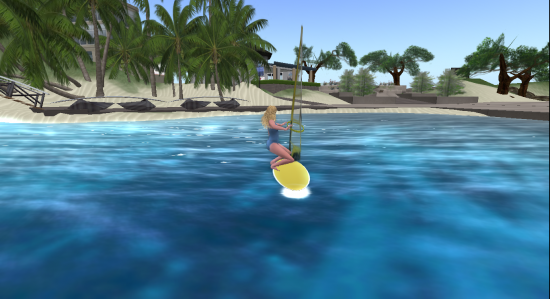The premise:Â I believe that we’re about to see the massive growth of a metaverse in which people can easily travel from one public world to another. Over time, the technology will become increasingly easy to use and realistic — and we will see an explosion of companies offering products and services in this metaverse. Â My team and I have been brainstorming some ideas of what these products and services will look like.

The business
Customers hypergrid teleport into a private grid where they can enjoy a variety of fitness activities, attend support groups, and get one-on-one help from nutritionists and other experts. They can also participate in competitive events, mixers, attend guest lectures, or go on group hikes or diving expeditions. Research has shown that participants in such programs can lose as much weight as in the real-world equivalents — while also forming new, lasting healthy habits. Startup costs are low because most of the technology and environments are already available off the shelf, while support groups and coaching don’t require heavy investment.
The revenue streams
In addition to club membership fees, grid owners can also make money by selling virtual home exercise equipment, clothing and accessories, one-to-one coaching, or lecture attendance fees. Grid owners can also use the grid to market real-world products such as memberships to traditional gyms and weight-loss programs, nutritional supplements, health and fitness magazine subscriptions, and similar related products. Grid owners can also rent out space to outside merchants.
Scalability
As the number of visitors grows, the company can add additional facilities, or duplicate existing ones to create more space. In addition, copies of smaller versions of the grid can be made available to corporations for private events, or for use as white label virtual corporate health centers. However, the need to hire additional trained staff to handle increased users will limit the rate of growth.
Competitive advantage
If the premise is successful, copycats will appear offering similar services. The first company will have a lead in name recognition, and in community building. New users will want to go to the fitness clubs that have the busiest facilities and the broadest array of programming. Later entrants into the space will have trouble matching that, unless they offer a substantially better product or service — however, the time it takes folks to switch over may also allow the first mover to upgrade its own offerings to compete.
Risks
Low barriers to entry and high personnel costs could quickly turn virtual fitness into a highly competitive sector filled with small and medium-sized providers.
- Analysts predict drop in headset sales this year - March 25, 2025
- OSgrid enters immediate long-term maintenance - March 5, 2025
- OSgrid wiping its database on March 21: You have five weeks to save your stuff - February 15, 2025
